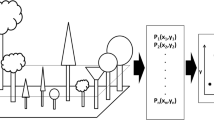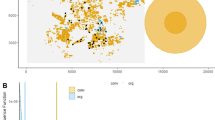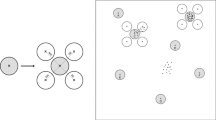Abstract
A Norton-Rice distribution (NRD) is a versatile, flexible distribution for k ordered distances from a random location to the k nearest objects. In a context of plotless density estimation (PDE) with n randomly chosen sample locations, and distances measured to the k = 6 nearest objects, the NRD provided a good fit to distance data from seven populations with a census of forest tree stem locations. More importantly, the three parameters of a NRD followed a simple trend with the order (1, …, 6) of observed distances. The trend is quantified and exploited in a proposed new PDE through a joint maximum likelihood estimation of the NRD parameters expressed as a functions of distance order. In simulated probability sampling from the seven populations, the proposed PDE had the lowest overall bias with a good performance potential when compared to three alternative PDEs. However, absolute bias increased by 0.8 percentage points when sample size decreased from 20 to 10. In terms of root mean squared error (RMSE), the new proposed estimator was at par with an estimator published in Ecology when this study was wrapping up, but otherwise superior to the remaining two investigated PDEs. Coverage of nominal 95% confidence intervals averaged 0.94 for the new proposed estimators and 0.90, 0.96, and 0.90 for the comparison PDEs. Despite tangible improvements in PDEs over the last decades, a globally least biased PDE remains elusive.
















Similar content being viewed by others
References
Anderson TW, Darling DA (1952) Asymptotic theory of certain “Goodness of Fit” criteria based on stochastic processes. Ann Math Stat 23:193–212
Baddeley A, Rubak E, Turner R (2015) Spatial point patterns: methodology and applications with R. CRC Press
Barbour MT, Gerritsen J (1996) Subsampling of benthic samples: a defense of the fixed-count method. J N Am Benthol Soc 15(3):386–391
Byth K (1982) On robust distance-based intensity estimators. Biometrics 38:127–135
Chambers RL (2011) Which sample survey strategy? A review of three different approaches. P J Stat 27:337–357
Chen MY, Tsai JL (1980) Plotless sampling methods for investigating the arboreal stratum of vegetation. Q J Chin For 13:29–38
Chen X, Fanz Y, Tsyrennikovx V (2006) Efficient estimation of semiparametric multivariate copula models. J Am Stat Assoc 101(475):1228–1240
Clayton G, Cox TF (1986) Some robust density estimators for spatial point processes. Biometrics 42:753–767
Coddington JA, Griswold CE, Silva D, Peqaranda E, Larcher SF (1991) Designing and testing sampling protocols to estimate biodiversity in tropical ecosystems In: The unity of evolutionary biology. Proceedings of the fourth international congress of systematic and evolutionary biology. Portland, OR, 1991.Vol Proceedings of the fourth international congress of systematic and evolutionary biology, 2 vols, p 44‒60.
Cogbill CV, Thurman AL, Williams JW, Zhu J, Mladenoff DJ, Goring SJ (2018) A retrospective on the accuracy and precision of plotless forest density estimators in ecological studies. Ecosphere 9:e02187
Condit R, Hubbell SP (1998) Tropical forest census plots: methods and results from barro colorado island. Panama Comp Other Plots, Springer, Berlin, p 211
Cottam G, Curtis JT (1956) The use of distance measures in phytosociological sampling. Ecology 37:451–460
Cressie NAC, Collins LB (2001) Analysis of spatial point patterns using bundles of product density LISA functions. J Agric Biol Environ Stat 6:1–118
Diggle PJ (1983) Statistical analysis of spatial point patterns. Academic Press, New York, p 148
Ducey MJ (2018) Design-unbiased point-to-object sampling on lines, with applications to areal sampling. Eur J For Res 137:367–383
Eberhardt LL (1967) Some developments in distance sampling. Biometrics 27:207–216
Efron B, Tibshirani RJ (1993) An introduction to the bootstrap. Chapman Hall, Boca Raton, p 436
Fehrmann L, Gregoire T, Kleinn C (2011) Triangulation based inclusion probabilities: a design-unbiased sampling approach. Environ Ecol Stat 19:107–123
Fischer M (2010) Multivariate copulae. In: Kurowicka D, Joe H (eds) Dependence modeling. World Scientific, Singapore, pp 19–36
Fleiss JL, Levin B, Paik MC (2013) Statistical methods for rates and proportions. Wiley, New York, p 800
Flores O (2005) Déterminisme de la régénération chez quinze espèces d'arbres tropicaux en forêt guyanaise: les effets de l'environnement et de la limitation par la dispersion, Université Montpellier II Montpellier Fr, p 307. https://tel.archives-ouvertes.fr/tel-00297707/document.
Gao M (2013) Detecting spatial aggregation from distance sampling: A probability distribution model of nearest neighbor distance. Ecol Res 28:397–405
Gerrard DJ (1969) Competition quotient: a new measure of the competition affecting individual forest trees. Mich State Univ Agric Exp Stn 20:1–14
Getis A, Ord JK (1992) The analysis of spatial association by use of distance statistics. Geogr Anal 24:189–206
Gregoire TG, Scott CT (2003) Altered selection probabilities caused by avoiding the edge in field surveys. J Agric Biol Environ Stat 8:36–47
Gupta A, Song D (1997) Lp-norm spherical distribution. J Statist Plan Infer 60:241–260
Haxtema Z, Temesgen H, Marquardt T (2012) Evaluation of n-tree distance sampling for inventory of headwater riparian forests of western oregon. W J Appl For 27:109–117
Holm S (1979) A simple sequentially rejective multiple test procedure. Scand J Stat 6:65–70
Illian J, Penttinen A, Stoyan H, Stoyan D (2008) Statistical analysis and modelling of spatial point patterns. Wiley, Chichester, p 534
Jamali H, Ebrahimi A, Ardestani EG, Pordel F (2020) Evaluation of plotless density estimators in different plant density intensities and distribution patterns. Glob Ecol Cons 23:e01114. https://doi.org/10.1016/j.gecco.2020.e01114
Kendall MG, Moran PP (1963) Geometrical probability. Charles Griffin, London, p 125
Kendall MG, Stuart A (1979) The advanced theory of statistics. MacMillan, London, pp 1–748
Kleinn C, Vilčko F (2006) A new empirical approach for estimation in k-tree sampling. For Ecol Manag 237:522–533
Koay CG, Basser PJ (2006) Analytically exact correction scheme for signal extraction from noisy magnitude MR signals. J Magn Reson 179:317–322
Koekoek R (1990) Generalizations of laguerre polynomials. J Math Anal Appl 153:576–590
Kronenfeld BJ (2009) A plotless density estimator based on the asymptotic limit of ordered distance estimation values. For Sci 55:283–292
Lessard VC, Drummer TD, Reed DDA (2002) Precision of density estimates from fixed-radius plots compared to n-tree distance sampling. For Sci 48:1–6
Levene H (1960) Robust tests for equality of variances. In: Olkin I (ed) Contributions to probability and statistics: essays in honor of harold hotelling. Standford Univ Press, Standford, pp 278–292
Lynch TB (2012) A mirage boundary correction method for distance sampling. Can J For Res 42:272–278
Lynch TB, Rusydi R (1999) Distance sampling for forest inventory in Indonesian teak plantations. For Ecol Manag 113:215–221
Magnussen S (2012a) Fixed-count density estimation with virtual plots. Spat Stat 2:33–46
Magnussen S (2012b) A new composite K-tree estimator of stem density. Eur J For Res 131:1513–1527
Magnussen S (2014) Robust fixed-count density estimation with virtual plots. Can J For Res 44:377–382
Magnussen S (2015) A fixed count sampling estimator of stem density based on a survival function. J For Sci 61:485–495
Magnussen S (2016) Improved fixed-count stand-level estimators of stem density, mean diameter, and basal area. Eur J For Res 135:191–202. https://doi.org/10.1007/s10342-015-0930-y
Magnussen S, Kleinn C, Picard N (2008) Two new density estimators for distance sampling. Eur J For Res 127:213–224
Magnussen S, Fehrmann L, Platt W (2011) An adaptive composite density estimator for distance sampling. Eur J For Res 131:307–320
Mark AF, Esler AE (1970) An assessment of the point-centred quarter method of plot-less sampling in some New Zealand forests. Proc N Z Ecol Soc 17:106–110
Møller J, Waagepetersen RP (2004) Statistical inference and simulation for spatial point processes. Chapman Hall/CRC, Boca Raton, p 312
Moore PG (1954) Spacing in plant populations. Ecology 35:222–227
Morisita M (1954) Estimation of population density by spacing method. Contributions from the department of biology, Faculty of Science, Kyushu University Series E (Biology). 1:187-197
Norton K, Rice P, Janes H, Barsis A (1955) The rate of fading in propagation through a turbulent atmosphere. Proc IRE 43:1341–1353
Nothdurft A, Saborowski J, Nuske RS, Stoyan D (2010) Density estimation based on k-tree sampling and point pattern reconstruction. Can J For Res 40:953–967
Ott PK, Errico D (2016) Revisiting fraser’s triangles as the basis for estimating tree density, spatial distribution, and stocking. For Sci 62:474–481
Persson O (1964) Distance methods: the use of distance measurements in the estimation of seedling density and open space frequency. Studia For Suec 15:1–68
Picard N, Kouyaté AM, Dessard H (2005) Tree density estimations using a distance method in Mali savanna. For Sci 51:7–18
Platt WJ, Evans GW, Rathbun SL (1988) The population dynamics of a long-lived conifer (Pinus Palustris). Am Nat 131:491–525
Pollard JH (1971) On distance estimators of density in randomly distributed forests. Biometrics 27:991–1002
Prodan M (1968) Punktstichprobe Für Die Forsteinrichtung [Point Sampling in Forest Inventory]. Forst- und Holzwirt 23:225–226
Raftery AE (1999) Bayes factors and bic: comment on “a critique of the bayesian information criterion for model selection.” Soc Met Res 27:411–427
Ramezani H, Grafström A, Naghavi H, Fallah A, Shataee S, Soosani J (2016) Evaluation of k-tree distance and fixed-sized plot sampling in zagros forests of western Iran. J Agric Sci Technol 18:155–170
Redfern D (1996) Standard functions and constants. The maple handbook. Springer, New York, pp 284–314
Ripley BD (1988) Statistical inference for spatial processes. Cambridge University Press, Cambridge, p 148
Rose ME (1953) The analysis of angular correlation and angular distribution data. Phys Rev 91:610–615
Safari M, Sefidi K, Alijanpour A, Elahian M (2020) Efficiency evaluation of the plotless method methods for estimating the spatial structure of Persian oak (Quercus macranthera) stands in Arasbaran forests. For Res Dev 5:599–612
Sarhan AE, Greenberg BG (1962) Contributions to order statistics. Wiley, New York, p 482
Schreuder HT, Gregoire TG, Wood GB (1993) Sampling methods for multiresource forest inventory. Wiley, New York, p 416
Shanks RE (1954) Plotless sampling trials in appalachian forest types. Ecology 35:237–244
Shen G, Wang X, He F (2020) Distance-based methods for estimating density of non-randomly distributed populations. Ecology 101(10):e03143
Sohrabi H (2018) Adaptive k-tree sample plot for the estimation of stem density: an empirical approach. J For Sci 64:17–24
Staupendahl K (2008) The modified six-tree-sample—a suitable method for forest stand assessment. Allg F Jagdztg. IEEE Trans Commun 179:21–33
Steinke I, Hennenberg KJ (2006) On the power of plotless density estimators for statistical comparisons of plant populations. Can J Bot 84:421–433
Stoyan DP (2000) Recent applications of point process methods in forestry statistics. Stat Sci 15:61
Stoyan D, Stoyan H, Tscheschel A, Mattfeldt T (2001) On the estimation of distance distribution functions for point processes and random sets. Image Anal Stereol 20:65–69
Zhu BC, Zeng ZQ, Cheng JL, Beaulieu NC (2017) On the distribution function of the generalized Beckmann random variable and its applications in communications. IEEE Trans Comm 66:2235–2250
Author information
Authors and Affiliations
Corresponding author
Additional information
Publisher's Note
Springer Nature remains neutral with regard to jurisdictional claims in published maps and institutional affiliations.
Project funding: The work was supported by the Canadian Forest Service.
The online version is available at http://www.springerlink.com.
Corresponding editor: Tao Xu
Appendix
Appendix
The mean (location) and variance of a Norton-Rice distribution (cf (1)) with parameters {mij, aij, bij} at the ith site and jth distance are given in (2) and (3). For the sake of completeness, the expressions for the skewness coefficient and the kurtosis is given next.
The skewness coefficient of a RND can be computed from the three parameters as per (15) with subscripts dropped for clarity.
The kurtosis for a RND is given next.
In both (15) and (16) the denominator inside the outermost parentheses is the variance given in (3). Correspondingly, the numerators in (15) and (16) are the third and fourth central moment.
A scaled version of Ripley’s K-function is often used to characterize a spatial point pattern (Illian et al. 2008). The scaled version used here is denoted \(L\left( {\overline{r}_{6,tree - tree} } \right)\) and defined in 17 for a population with N trees a known stem density \(\lambda\), and an average distance from a stem location to the 6th nearest tree location \(\left( {\overline{r}_{6,tree - tree} } \right)\).
where \(K\left( {\overline{r}_{6,\,tree - tree} } \right)\) is the length N vector of Ripley’s K-function yielding the number of trees inside a disk with a radius \(\overline{r}_{6,tree - tree}\) centered on the ith stem-location (i = 1, …, N), and wts is the length N vector of edge-corrections (here the ratio between the nominal area of the disk and the area of the disk inside the boundaries of the studied population).
The pair-correlation function \(g\left( {\overline{r}_{6,tree - tree} } \right)\) is also a popular statistic for the inference about spatial point patterns (Illian et al. 2008). Here a discrete version is used with 10-cm wide distance bins. Specifically:
where rij is the distance from the ith tree to the jth tree \(j_{ \ne i} = 1, \ldots ,N\) in the population. To minimize edge effects, the boundary mirage by Lynch (Ibid) was used.
Rights and permissions
About this article
Cite this article
Magnussen, S. A plotless density estimator with a Norton-Rice distribution for ordered distances. J. For. Res. 32, 2385–2401 (2021). https://doi.org/10.1007/s11676-021-01309-9
Received:
Accepted:
Published:
Issue Date:
DOI: https://doi.org/10.1007/s11676-021-01309-9




